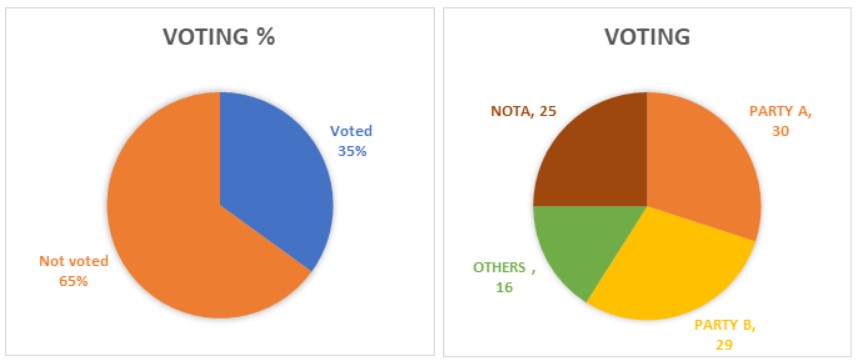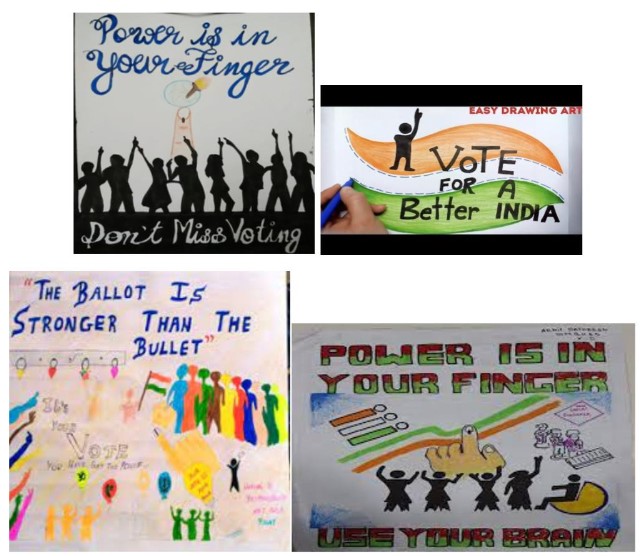August Activity – Power of Vote
OBJECTIVES
Students will be able to identify the power of the vote in a democracy.
EXPECTED OUTCOMES
Students will describe the importance and power of a vote in a democratic set-up.
SKILLS AND VALUES
Communication, creativity
Accountability, benevolence
SESSIONS’ OVERVIEW
| S. No. | Session Details | Estimated Time Required |
| 1 | Step 1: Introduction
Step 2: Task Step 3: Debrief |
45 min |
| 2 | Step 4: Presentation
Step 5: Debrief |
45 min |
MATERIAL REQUIRED
Pen, sheets, notebook, textbooks, art materials such as sketch pens, paints, colours etc. as available(optional).
STEPS OF THE ACTIVITY
Session 1: For a 45 min session Step 1-2
Step 1 - Introduction
Estimated time – 10 mins.
1. Teacher will begin the class asking these questions:
- Have you ever seen someone not willing to vote on an election day?
- Do you know someone who thinks voting is a waste of time and energy?
- Why do you think everyone should go for vote?
Take 1-2 responses for each question.
2. Teacher narrates a situation about Country Alpha. 

Off the 35 percent voter turnout, the polling results came out as follows:
- Party A - 30%
- Party B - 29%
- Others - 16%
- NOTA - 25%
Because party A got majority vote, they will be invited to form government. They can make collation with another party to proof majority. But only 30 percent have voted for them. If there would have been higher voter turnout, this could be a different situation too. There would have been a possibility that party A still gets majority vote, but higher representation. There could also be a possibility that some other party would have got higher representation. Every country spends crores of rupees which is taxpayers’ money to conduct elections.


Teacher can quote few figures from the image. (Optional)
3. Tell students: Now imagine a situation like this in your country and State. You are a group of people really concerned about this lack of participation of the voters. What will be some of the activities you will want to do?
Teacher will then tell that today, you all will prepare an awareness campaign for the ‘Power of Vote’.
Step 2 – Group Activity
Estimated time – 30-35 mins.
1. Divide students into 2 groups.
2. In each group, some students will make Posters, some will make Slogans and other remaining will prepare Nukkad Natak. Students will use these Posters and slogans in Nukkad Natak.
Note: Nukkad Natak/Street play purpose is to inform and educate people about social issues. It is generally done in public place to spread awareness. The objective here is to provide opportunity to students to experience how it is done. The presentation will be in classroom/school.
3. Each group will divide the tasks prepare 2-3 posters, 2-3 slogans for the rally on the power of voting. They can use available materials. Rough papers, drawing papers, notebook pages etc. The group will prepare Nukkad natak using the script given in Annexure 1. They can add few dramatic elements and lines but ensuring the Natak finishes in 7-10 minutes.
4. Teacher can share the reference points and script with each group given in Annexure 1.
5. Tell the students they have 30 minutes to do the task.
Note: Teacher to ensure that in the groups everyone is involved. For Nukad Natak, teacher will need to give them directions for voice, claps, etc as mentioned in Reference section.
NOTE: Teacher will need to pre-inform when the next class is going to be conducted so that the students can come prepared for the Presentation.
Session 2: For a 45 min session Step 3-4
Recap: 5 mins
Ask students about the previous activity. Ask them about their experience while preparing the Nukkad natak and the posters along with slogans. (Take 2-3 responses) Talk about the objective of the entire campaign/rally and how it aims at making citizens more aware, active and engaging in the process of voting.
Step 3 - Presentation
Estimated Time: 30 mins.
- Divide students into the same groups as the previous session & invite them to present. First Group 1 can present followed by Group 2.
- Teacher can also arrange for this presentation to be in Assembly/function, or it can be a rally where first the group 1 presents followed by group 2 (Optional)
- Each group gets 10 mins to perform.
Step 4 - Debrief
Estimated Time: 10 mins.
Teacher can debrief with help of following Questions:
- How do you all feel? Did you enjoy it?
- Do you think that such awareness campaigns should be done regularly? Why or why not?
- What is your learning about voting being a powerful tool for citizens? Share one key learning.
- Suggest one such initiative that you would like to bring in your community to bring out the maximum number of eligible voters to participate in the process.
Reflection Sheets, Activity Report & Feedback Form
Teachers kindly fill in the feedback form, remind office bearers to fill activity report and remind students also to fill up the reflection sheets.
REFERENCE SECTION
Annexure 1 – Group Work Outline
Directions for Awareness Posters and Slogans
Points for Reference
· Clear Awareness messages in BOLD aligned to Nukkad Natak theme
· Keep the slogan and messages brief.
· Messages/Slogan can be in Regional/English Language
· Take care of spelling and grammar
· It can be black & white posters or colored as per the materials available.
Example for Slogans: ‘MY VOTE MY NATION MY PRIDE’ ‘EK VOTE ANEKO BHENT’


Image references: https://www.ceopunjab.gov.in/photogallery?id=4
Group 1: Nukkad Natak Script
There are six characters in the natak:
1. Ravi
2. Priya
3. Ananya
4. Deepak
5. Politician
6. Crowd Members
Note: Everyone will stand in Circle/rectangle (as possible in class), and when the characters perform, they will sit at their place in circle so that characters can be seen.
Opening Line (2 times): Aao aao, natak dekho. Aao aao, natak dekho. (Everyone moves in the circle, says loudly and claps)
(Everyone will sit, and Politician will come inside the circle and says the line – student can wear the politician role tag)
Politician: (Energetic) Saathyion. Thank you for coming today. It has been a good term of 5 years with you all. I promise that this time if you vote for me, we will build a new school with high class facilities.
Someone from the crowd: But Netaji, where is that road you promised last time?
Everyone says together: Bolo Netaji Bolo Netaji!
(Ananya will come inside – student can wear the role tag)
Ananya: (Passionately to the crowd) But friends, this is the beauty of our democracy, we can choose a suitable representative for us. Let us make sure we use the power to choose the right one this time.
(Everyone goes back to the circle)
Everyone sings together 2 times: Suno Suno! Suno Suno! WE HAVE THE POWER OF CHOOSING REPRESENTATIVES
(Everyone moves/sits in the circle, says this loudly and claps softly)
(Ravi, Priya and Deepak will come inside – student can wear the name tag)
Ravi: (Disappointed) Priya, can you believe it? This man is standing here again. Asking for our votes. He has not done anything for our community. Why should we vote anyway? No one does anything for us.
Priya: I understand that this politician has not done anything, so we change him. How do we do that?
Deepak: By voting my friend. Vote is our biggest power.
(Everyone goes back to the circle)
Everyone says together 2 times: VOTE IS OUR BIGGEST POWER!
Everyone takes the pledge together – “Aao hum sab Desh Apnayen, chalta hai ko door bhagaya, bhavishya bachayen, Bhagya banayen. Hum badlenge, desh badlega”
Group 2: Nukkad Natak Script
There are six characters in the natak:
1. Seema
2. Ali
3. Rita
4. James
5. Divya
6. Rajiv
7. Crowd Members
Note: Everyone will stand in Circle/rectangle (as possible in class), and when the characters perform, they will sit at their place in circle so that characters can be seen.
Opening Line (2 times): Aao aao, natak dekho. Aao aao, natak dekho. (Everyone moves in the circle, says loudly and claps)
(Seema and Rita will come inside – student can wear the role tag)
Seema: Oh, look Rita, the politician is again giving empty promises to us. Where is the school or the road he promised us last time? Where is it?
Everyone says together: Where is it? Where is it? (OR To add drama element, group can say – batao batao kahan hai? Kidhar hai? - optional)
Rita: Seema, you say that he did not fulfil his promises. But how do you know this? How did you say that so confidently?
Seema: I saw his manifesto.
Everyone says together: Manifesto? What is that? (OR To add drama element, group can say – Ye Manifesto, manifesto kya hai, ye manifesto manifesto? - optional)
(Ali will come inside – student can wear the role tag)
Ali: (Looking towards the crowd and circling and telling everyone): Manifesto is a document which every party shares with the people when asking for votes. It has a list of things that they will do for the people. We should make sure we read the manifestos of all the candidates before voting.
(Everyone goes back to the circle)
Everyone sings together 2 times:: Suno Suno! Suno Suno! MAKE SURE TO READ THE MANIFESTO
(Divya will come inside)
Divya: WOW! Now that I have read the Manifesto, that also gives a chance to make better decisions when we vote.
(James and Rajiv will come inside)
James: Yes, infact I always thought it is a waste of time to vote but now after reading the manifesto, I am looking forward to vote.
Rajiv: (Passionately to the crowd): Well James! Voting makes the government. Voting is the biggest way through which you can contribute to your society. Each vote counts.
James: Then this time we should make sure that maximum of us vote.
(Everyone goes back to the circle)
Everyone sings together 2 times: Suno Suno! Suno Suno! EACH VOTE COUNTS (Everyone moves/site in the circle, says this loudly and claps softly)
Everyone takes the pledge together – “Hum bharat ke log, apne desh ki tarraki ke liye apne matdaan ke adhikar ka humesha paalan karenge. Hum badlenge, desh badlega”
Note for Teacher: Points to consider for Nukkad Natak:
· Teams can sing / dance by themselves to create the necessary music or sound.
· Signature Clap to be decided by group (like single clap or double clap), to follow when collective messaging is given.
· Everyone has to be loud but do not shout when giving collective messaging.
· Every person who enacts needs to be loud, so that others can hear the dialogues.
· Practice at least 2-3 times before the final presentation.
Reference Links: Power of voting: https://youtu.be/kKQmN_xYhkE
Nukkad Natak references: https://www.youtube.com/watch?v=ha84ttOlaZ0



